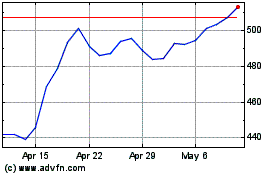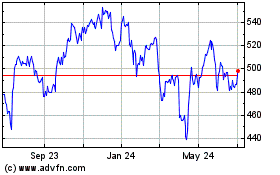The 10-Point.
August 29 2016 - 8:32AM
Dow Jones News
By Gerard Baker
Good morning,
Unhealthy Monopoly
Nearly a third of U.S. counties look likely to have just a
single insurer offering health plans on the Affordable Care Act's
exchanges next year, an industry retreat that adds to the manifold
challenges facing the law. A new study, by the nonpartisan Kaiser
Family Foundation, suggests there could be just one option for
coverage in 31% of counties in 2017, and there might be only two in
another 31%. Companies including UnitedHealth, Humana and Aetna
have cited their losses in withdrawing from ACA marketplaces, as
have smaller insurers. Those that remain are in some cases seeking
sharp premium increases for next year, a demand made much easier
when there is no competition. And at least one county is at risk of
having no insurers offering marketplace plans next year, a problem
especially for lower-income Americans who are generally required to
buy ACA plans to qualify for federal subsidies.
Rush for Cash
A flood of share debuts is expected to invigorate the listless
market for initial public offerings after the Labor Day holiday,
but the revival might be short-lived. Companies in a wide variety
of U.S. industries plan to go public after the long weekend, and
the level of new issuance should resemble what would normally be
expected given record stock prices and historically low volatility.
But the window for offerings is expected to shut about six weeks
later amid political uncertainty ahead of the presidential
election. One of the largest expected IPOs is Valvoline, an engine
and automotive-maintenance business that is being spun off from
Ashland, and another closely watched deal is Nutanix, a Silicon
Valley software company that would be one of the few billion-dollar
startups to debut this year. Still, 2016 will likely go down as a
brutal year for new issuance overall.
Power Surge
A startling energy bonanza has gone almost unnoticed in Texas:
the rise of renewables. The Lone Star state has added more
wind-based generating capacity than any other, with wind turbines
accounting for 16% of electrical generating capacity as of April,
and is anticipating a huge surge in solar power. We report that at
a time when debate is raging between political parties over climate
change, and critics charge that "green energy" is little more than
a government creation, Texas has taken an approach that works
within the state's free-market-based electricity system. And state
officials say wind and solar are almost certain to play a
significant and growing role in the state's energy future even when
federal subsidies decline in coming years.
The Electric Age
Mass adoption of electric vehicles is coming, and much sooner
than most people realize, writes our Personal Technology columnist
Christopher Mims. Electric cars are gadgets, and technological
change in gadgets is rapid. A typical electric vehicle today costs
$30,000 and will go about 100 miles on a charge, if that. Within a
year, you'll be able to get double that range for just a little
more money. Tesla, promising its $35,000 Model 3 vehicle, is the
standard-bearer, but it is hardly alone. Competition among electric
vehicles and plug-in hybrids will be intense, which will drive down
prices. In the short run, many cars will be plug-in hybrids, with
both electric motors and gasoline engines. Meanwhile, the
proliferation of charging stations, especially at businesses and
workplaces, will entice demand.
--Compiled by Margaret Rawson
(END) Dow Jones Newswires
August 29, 2016 08:17 ET (12:17 GMT)
Copyright (c) 2016 Dow Jones & Company, Inc.
UnitedHealth (NYSE:UNH)
Historical Stock Chart
From Mar 2024 to Apr 2024

UnitedHealth (NYSE:UNH)
Historical Stock Chart
From Apr 2023 to Apr 2024
